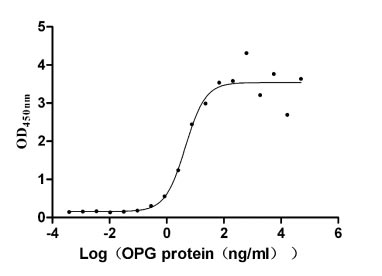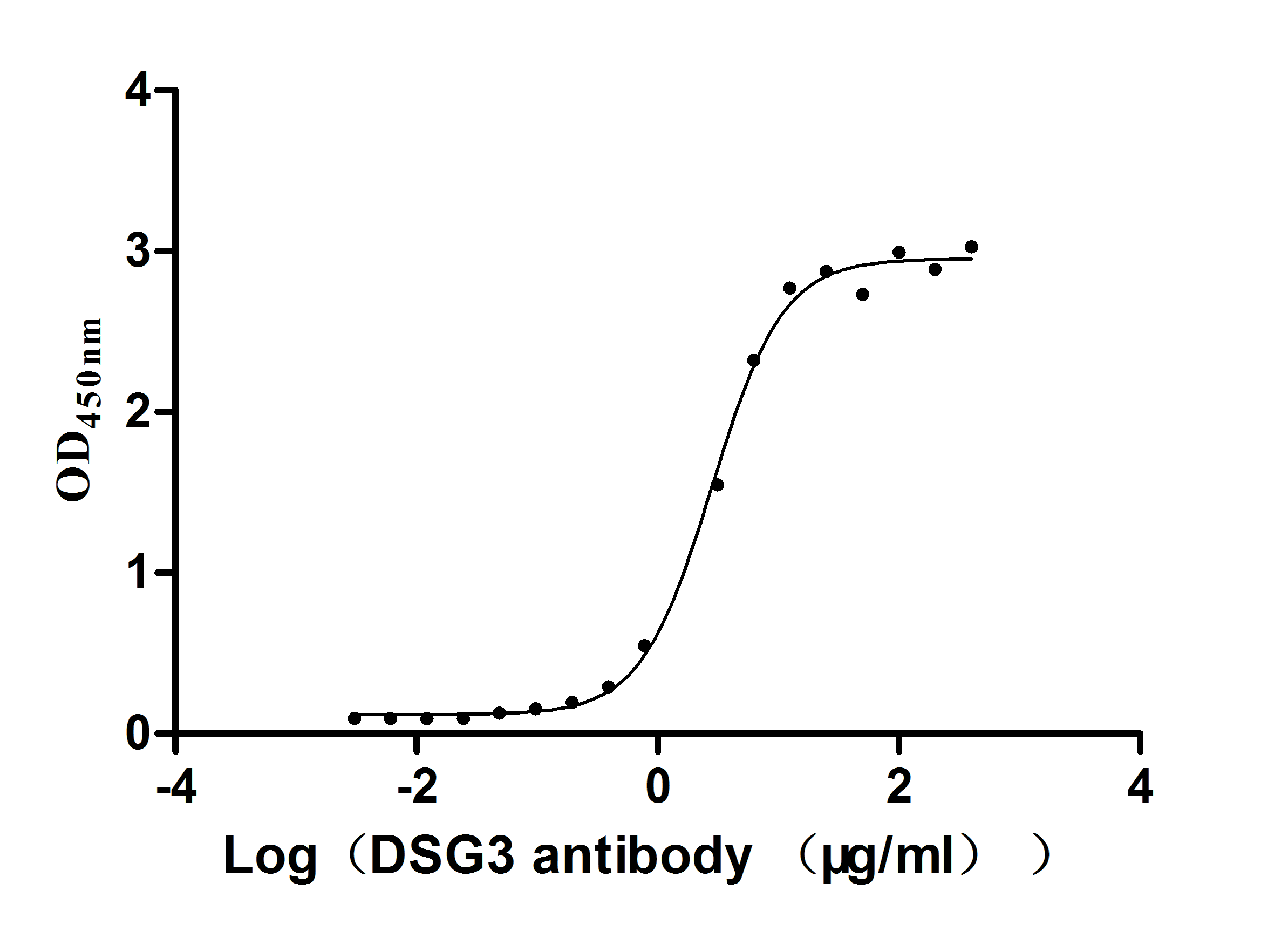Recombinant Human E3 ubiquitin-protein ligase FANCL (FANCL)
-
中文名称:人FANCL重组蛋白
-
货号:CSB-YP882120HU
-
规格:
-
来源:Yeast
-
其他:
-
中文名称:人FANCL重组蛋白
-
货号:CSB-EP882120HU
-
规格:
-
来源:E.coli
-
其他:
-
中文名称:人FANCL重组蛋白
-
货号:CSB-EP882120HU-B
-
规格:
-
来源:E.coli
-
共轭:Avi-tag Biotinylated
E. coli biotin ligase (BirA) is highly specific in covalently attaching biotin to the 15 amino acid AviTag peptide. This recombinant protein was biotinylated in vivo by AviTag-BirA technology, which method is BriA catalyzes amide linkage between the biotin and the specific lysine of the AviTag.
-
其他:
-
中文名称:人FANCL重组蛋白
-
货号:CSB-BP882120HU
-
规格:
-
来源:Baculovirus
-
其他:
-
中文名称:人FANCL重组蛋白
-
货号:CSB-MP882120HU
-
规格:
-
来源:Mammalian cell
-
其他:
产品详情
-
纯度:>85% (SDS-PAGE)
-
基因名:
-
Uniprot No.:
-
别名:E3 ubiquitin-protein ligase FANCL; FAAP43; Fancl; FANCL_HUMAN; Fanconi anemia complementation group L; Fanconi anemia group L protein; Fanconi anemia-associated polypeptide of 43 kDa; FLJ10335; PHD finger protein 9; PHF9; POG; Ubiquitin ligase protein FANCL
-
种属:Homo sapiens (Human)
-
蛋白长度:Full Length of Mature Protein
-
表达区域:2-375
-
氨基酸序列AVTEASLLR QCPLLLPQNR SKTVYEGFIS AQGRDFHLRI VLPEDLQLKN ARLLCSWQLR TILSGYHRIV QQRMQHSPDL MSFMMELKML LEVALKNRQE LYALPPPPQF YSSLIEEIGT LGWDKLVYAD TCFSTIKLKA EDASGREHLI TLKLKAKYPA ESPDYFVDFP VPFCASWTPQ SSLISIYSQF LAAIESLKAF WDVMDEIDEK TWVLEPEKPP RSATARRIAL GNNVSINIEV DPRHPTMLPE CFFLGADHVV KPLGIKLSRN IHLWDPENSV LQNLKDVLEI DFPARAILEK SDFTMDCGIC YAYQLDGTIP DQVCDNSQCG QPFHQICLYE WLRGLLTSRQ SFNIIFGECP YCSKPITLKM SGRKH
-
蛋白标签:Tag type will be determined during the manufacturing process.
The tag type will be determined during production process. If you have specified tag type, please tell us and we will develop the specified tag preferentially. -
产品提供形式:Lyophilized powder
Note: We will preferentially ship the format that we have in stock, however, if you have any special requirement for the format, please remark your requirement when placing the order, we will prepare according to your demand. -
复溶:We recommend that this vial be briefly centrifuged prior to opening to bring the contents to the bottom. Please reconstitute protein in deionized sterile water to a concentration of 0.1-1.0 mg/mL.We recommend to add 5-50% of glycerol (final concentration) and aliquot for long-term storage at -20℃/-80℃. Our default final concentration of glycerol is 50%. Customers could use it as reference.
-
储存条件:Store at -20°C/-80°C upon receipt, aliquoting is necessary for mutiple use. Avoid repeated freeze-thaw cycles.
-
保质期:The shelf life is related to many factors, storage state, buffer ingredients, storage temperature and the stability of the protein itself.
Generally, the shelf life of liquid form is 6 months at -20°C/-80°C. The shelf life of lyophilized form is 12 months at -20°C/-80°C. -
货期:Delivery time may differ from different purchasing way or location, please kindly consult your local distributors for specific delivery time.Note: All of our proteins are default shipped with normal blue ice packs, if you request to ship with dry ice, please communicate with us in advance and extra fees will be charged.
-
注意事项:Repeated freezing and thawing is not recommended. Store working aliquots at 4°C for up to one week.
-
Datasheet :Please contact us to get it.
相关产品
靶点详情
-
功能:Ubiquitin ligase protein that mediates monoubiquitination of FANCD2 in the presence of UBE2T, a key step in the DNA damage pathway. Also mediates monoubiquitination of FANCI. May stimulate the ubiquitin release from UBE2W. May be required for proper primordial germ cell proliferation in the embryonic stage, whereas it is probably not needed for spermatogonial proliferation after birth.
-
基因功能参考文献:
- A novel homozygous mutation c.822_823insCTTTCAGG (p.Asp275LeufsX13) in the FANCL gene identified in a Chinese patient with Fanconi anemia. PMID: 28419882
- Using small interfering RNA (siRNA), knockdown of FANCF, FANCL, or FANCD2 inhibited function of the FA/BRCA pathway in A549, A549/DDP and SK-MES-1 cells, and potentiated sensitivity of the three cells to cisplatin. PMID: 26385482
- Loss-of-Function FANCL Mutations Associate with Severe Fanconi Anemia Overlapping the VACTERL Association PMID: 25754594
- a signal transduction pathway involved in self-renewal and survival of hematopoietic stem cells also functions to stabilize FANCL and suggesting that FANCL participates directly in support of stem cell function. PMID: 23783032
- FAVL elevation can increase the tumorigenic potential of bladder cancer cells, including the invasive potential that confers the development of advanced bladder cancer. PMID: 22828653
- Suppression of FANCL expression in normal CD34(+) stem and progenitor cells results in fewer beta-catenin active cells and inhibits expansion of multilineage progenitors. PMID: 22653977
- FA DNA repair genes, FANCD2, FANCL, and FANCC, are transcriptionally upregulated differently in melanoma compared with non-melanoma skin cancer PMID: 21697891
- genetic diversity in FANCA, FANCC and FANCL does not support an association of these genes with cervical cancer susceptibility in the Swedish population. PMID: 21543111
- FANCL is associated with acute lung injury in mice PMID: 21297076
- expression of a novel splice variant of FA complementation group L (FANCL), named FAVL, can impair the FA pathway in non-FA tumor cells and act as a tumor promoting factor PMID: 20407210
- data suggest that PHF9 has a crucial role in the Fanconi anemia pathway as the likely catalytic subunit required for monoubiquitination of FANCD2 PMID: 12973351
- FANCL, via its WD40 region, binds the FA complex and, via its PHD, recruits an as-yet-unidentified E2 for mono-ubiquitination of FANCD2 PMID: 16474167
- Abnormal FANCL expression is the cause leading to a defective Ranconi anemia-BRCA pathway, conferring sensitivity of a lung cancer cell line to mitomycin C> PMID: 17106252
- the first report to describe hypermethylation of FANCC in leukemia PMID: 18607065
- Upon the occurrence of DNA damage, FANCI becomes monoubiquitinated on Lys-523 by the UBE2T-FANCL pair. PMID: 19589784
- results rule out a major role of FANCL in familial breast cancer susceptibility PMID: 19737859
- FANCL is necessary for primordial germ cell proliferation during the embryonic stage but not necessary for spermatogonia proliferation in adulthood. Thus, mouse FancL-/- males are infertile at 7 to 12 weeks but gain fertility thereafter. PMID: 12606378
- Deficiency of Fancl (also called Pog) is the cause of gcd mouse, which has a reduced number of primordial germ cells during the embryonic stage. PMID: 12417526
显示更多
收起更多
-
相关疾病:Fanconi anemia complementation group L (FANCL)
-
亚细胞定位:Cytoplasm. Nucleus.
-
数据库链接:
HGNC: 20748
OMIM: 608111
KEGG: hsa:55120
STRING: 9606.ENSP00000385021
UniGene: Hs.631890
Most popular with customers
-
Recombinant Human T-cell immunoreceptor with Ig and ITIM domains (TIGIT), partial (Active)
Express system: Mammalian cell
Species: Homo sapiens (Human)
-
Recombinant Human Tumor necrosis factor receptor superfamily member 11B (TNFRSF11B) (Active)
Express system: Mammalian cell
Species: Homo sapiens (Human)
-
Recombinant Mouse Desmoglein-3 (Dsg3), partial (Active)
Express system: Mammalian cell
Species: Mus musculus (Mouse)
-
Recombinant Human Intestinal-type alkaline phosphatase (ALPI) (Active)
Express system: Mammalian cell
Species: Homo sapiens (Human)
-
Recombinant Human Claudin-6 (CLDN6)-VLPs (Active)
Express system: Mammalian cell
Species: Homo sapiens (Human)
-
Recombinant Macaca fascicularis lymphocyte antigen 6 family member G6D (LY6G6D) (Active)
Express system: Yeast
Species: Macaca fascicularis (Crab-eating macaque) (Cynomolgus monkey)
-
Recombinant Human Desmoglein-2 (DSG2), partial (Active)
Express system: Mammalian cell
Species: Homo sapiens (Human)
-
Recombinant Human Serine/threonine-protein kinase receptor R3 (ACVRL1), partial (Active)
Express system: Baculovirus
Species: Homo sapiens (Human)






-AC1.jpg)













